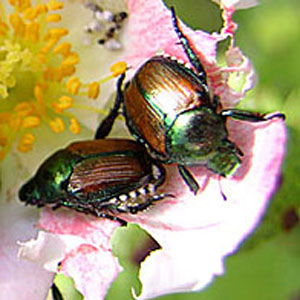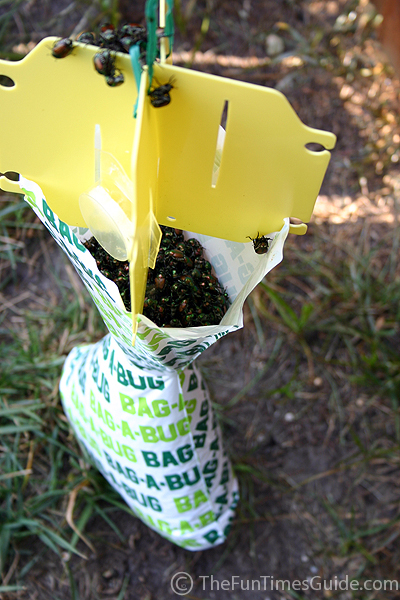Dealing with the scourge of Japanese Beetles has been an integral part of my gardening experience, ever since my early years as an enthusiastic apprentice gardener to my grandmother. She had two hybrid tea rose bushes gracing the end of one of her neatly laid out beds. I grew excited when they began to flower, as the swollen pink and yellow buds promised to make perfect live models for my nascent attempts at cake decorating, which I was strongly leaning towards as an alternate activity to pee wee football, which my brothers had so enthusiastically adopted. I was bursting with excitement the day I was to go to my grandmother’s to select a couple frosting blossom models from her bushes laden with beauties. The sight that greeted me however, was a nightmare. Where the week before creamy buds and blooms once dazzled, now hung pallid, sickly half-eaten, limp excuses for blossoms. How could I practice floral frosting roses using these!? I needed healthy, voluptuous, All-American Sport Illustrated swimsuit type floral frosting models, not some raggedy straggly cast-offs! Even if I had possessed the same cutting edge aesthetic of a decades later Calvin Klein, I doubt the heroin-chic look would have translated to cake décor. Then I noticed something else. Munching away on the blooms, or hovering lazily around the bushes, were dozens of glittering, medium sized insects.
“Japanese beetles” My grandmother explained. “I bought some traps, but it might be too late. “
Indeed, nearby were two attractive looking lantern type objects with mesh bottoms, hanging on curved poles stuck in the ground. Every minute or two, a beetle would lazily fly into the top, and down through the narrow neck into the bottom part. I didn’t quite understand why they didn’t just fly out, but judging from the hundreds of tiny legs slightly moving through the small openings in the mesh, there wasn’t enough space for them to get airborne. I had conflicting emotions. I hated what they did to the roses, but also hated to think of them all piled on top of each other cheek and mandible, futilely trying to figure out what just happened. I had a problem with the death of almost any living creature that appeared big enough to look at you. The beetles, although destructive, had a certain beauty of their own, with their iridescent wings and oval shapes. The fact that they could be so easily trapped made me feel doubly bad for them.
“Um, how long does it take for them to die?” I hesitantly asked my grandmother, transfixed by the hundreds of captives.
“Oh, not long at all.” she replied. With that she disappeared, returning a few minutes later with a coffee can, gasoline sloshing in the bottom of it. Realizing their fate, I said a quick prayer for the future dead beetles’ souls. No prayer for the dead could prepare me for what happened next though. She handed me the can. I am not quite sure if she decided that as a male, I should do the dirty work, or by virtue of her marrying my grandfather, my being one-sixteenth German made me better suited to these things. The horror having to commit Japanese Beetle genocide paralyzed me. Sensing my hesitation, she unhooked one of the lanterns, and firmly directed me to hold it upside down, close to the mouth of coffee can and shake vigorously. Within a few minutes, blood was on my hands. I went home exhausted, having gone through a rite of initiation, compounded with the realization that being a gardener was not just a bed of roses, and had a dark side. Recovery took a while. In the meantime, my dreams of perfecting frosting roses using live models died too. There were too many negative associations.
In recent times, as a not-quite so sensitive adult with roses of my own, I have adopted a thicker skin when it comes to dealing with beetles. In my early days at Schoolfield, there was more of a formal rose garden to tend, and my handyman sprayed the bushes. Wearing a mask and gloves, he cautioned me not to come near the garden for at least twenty minutes after he sprayed. I hesitated to ask what he used, but the roses did fine, with nary a beetle-bite on them (also nary a butterfly bee or hummingbird to be found in the vicinity). When the formal rose garden thankfully went away, replaced with rugosas, shrub roses and climbers integrated with the rest of my plants, so did the wholesale spraying. I adopted a greener, more holistic approach, also known as laying out a welcome mat for the Japanese beetles. The first round of blooms on the roses in late spring did fine. Then every year, sometime in mid-June, I would come up on a weekend and find a beetle jamboree happening out back. I tried sprinkling milky spores and nematodes on the ground, which in theory would multiply and eventually eat most of the beetle grubs n the ground. It didn’t seem to work.
“Be patient,” I was told, “Sometimes it can take a couple of years”. I waited three, and still no change. I bought a number of modern traps, which collected the beetles in disposable plastic bags hanging from them. I captured multitudes (allowing them to die natural deaths from starvation or exposure, or however they pass in those things). Still, as many as I caught, it didn’t seem to make a dent in the number of beetles on the roses. The onslaught continued. It was then I learned that the pheromones or whatever bait was used in the traps could attract beetles from hundreds of yards or miles away, from neighbors yards and just about anywhere downwind. I was unwittingly inviting beetles from all over the county to come to my garden for a huge, albeit potentially lethal orgy! I finally gave up on the traps altogether when something, whether an opossum or raccoon, managed to claw open some low hanging traps, allowing the living captives to escape, and their dead brethren to fall to the ground below, forming stinking piles of beetle corpses.
I captured multitudes (allowing them to die natural deaths from starvation or exposure, or however they pass in those things). Still, as many as I caught, it didn’t seem to make a dent in the number of beetles on the roses. The onslaught continued. It was then I learned that the pheromones or whatever bait was used in the traps could attract beetles from hundreds of yards or miles away, from neighbors yards and just about anywhere downwind. I was unwittingly inviting beetles from all over the county to come to my garden for a huge, albeit potentially lethal orgy! I finally gave up on the traps altogether when something, whether an opossum or raccoon, managed to claw open some low hanging traps, allowing the living captives to escape, and their dead brethren to fall to the ground below, forming stinking piles of beetle corpses.
Finally, about three years ago, I had had enough. One day I grabbed a coffee can out of the barn, and filled half way up with gasoline. I approached each bush, and grabbed a stem with beetles clinging to it. Holding the coffee can underneath, I would give it a firm shake. Some beetles hung on. Some landed to the ground, while others flew away. A number of them, though, fell into a petroleum-based death. Perhaps because I was older and less sensitive, or perhaps by allowing a number to escape, I felt it was a form of natural selection, or perhaps (and most likely) because I had just watched an episode of Cake Wars and partially blamed the beetles for what I never had the chance to become, I felt no remorse. Even odder, last year came, and nary a beetle landed in my garden. I thought perhaps it was something cyclical, and they would be back this summer with a vengeance. To my surprise and delight, they didn’t! I don’t know if over time, those little nematodes actually did their job, or if through the beetle communication channels, word slipped out about the revival of the coffee can death pool in my yard, or if I was just lucky for two years in a row. Whatever the case, I appreciated it!


